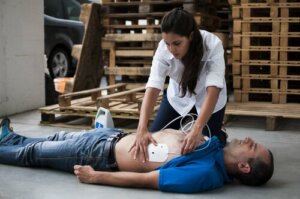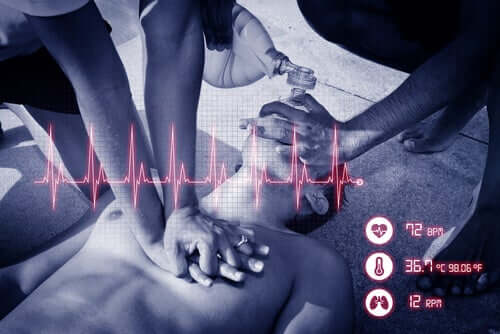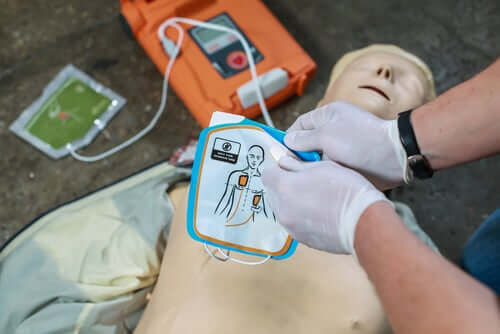How to Respond when Someone Has a Sudden Cardiac Arrest


Written and verified by the doctor Leonardo Biolatto
A sudden cardiac arrest is a situation in which a person’s breathing and blood circulation stop abruptly. It’s a critical moment that puts the life of the person who experiences it at risk. However, it’s potentially reversible if properly attended.
What does “potentially reversible” mean?
Well, that you can really help a person if you take quick, proper action.
However, it’s important to note that this isn’t like in the movies so sudden cardiac arrest is surrounded by all sorts of myths. In fiction, the person suddenly wakes up as if nothing happened after someone does CPR. This is quite a departure from reality. A person will only regain consciousness through electrical stimulation of the heart in a real situation.
Thus, you can really be of help if you know how to act in this event. Continue reading this article to learn some tips about what to do in the event of sudden cardiac arrest.
It’s important to know how to respond when someone has a sudden cardiac arrest
Both blood circulation and breathing stop when a person has a sudden cardiac arrest. What this means is oxygen doesn’t reach all parts of the body. Unfortunately, the brain will experience serious damage if this situation lasts longer than six to eight minutes.
This is why it’s so important to take quick action as 80% of cases occur outside the healthcare environment. In fact, almost 60% occur in the person’s own home. Currently, estimates indicate that only six out of every 100 people know what to do in this situation.
Those undergoing a sudden cardiac arrest require basic life support. In other words, it’s all about replacing the functions the person has lost by taking some simple measures.
The goal here is to maintain the flow of oxygen and blood circulation until professional health services arrive. They’ll then stimulate the heart again to try to reverse it.

Read about Five Ways To Recognize A Heart Attack
What to do in the event of sudden cardiac arrest?
The first thing you must do is know how to recognize this situation. When faced with an unconscious person, you must try to stimulate them so they regain consciousness. It’s important to talk to them and shake them intensely.
Also, make sure you’re in a safe environment. For example, are they lying in the middle of the road? You must place them away from danger then. Ideally, contact an emergency service as soon as possible.
However, don’t waste any time if you’re sure the person is having a sudden cardiac arrest. Place them on their back and gently push their head backward. This is to maintain the airway open. Just hold the forehead with one hand and the chin with the other.
It’s important to be able to describe and explain all the details of the situation when contacting the emergency services. Also, follow their instructions and have someone else find the nearest defibrillator if you’re not alone.
Semi-automatic defibrillators are available in some public places. In any case, it’ll be necessary to begin CPR (cardiopulmonary resuscitation) until health services arrive.

Doing CPR
Cardiopulmonary resuscitation consists of chest compressions and ventilation. You must be over the person to do chest compressions. Outstretch your arms and place your hands in the center of the chest.
Vigorously apply 30 rhythmic chest compressions and then breathe into the unconscious person’s mouth — inhale the air forcefully. The protocol indicates alternating two ventilations and then following up with chest compressions.
This is a simple but thorough maneuver. Therefore, rescuers should relieve each other and replenish their strength as they do the chest compressions if there’s someone nearby. You can save someone’s life by learning to do these maneuvers well.
All cited sources were thoroughly reviewed by our team to ensure their quality, reliability, currency, and validity. The bibliography of this article was considered reliable and of academic or scientific accuracy.
- Parada Cardiorrespiratoria (PCR) – Fundación io. (n.d.). Retrieved February 18, 2020, from https://fundacionio.com/soluciones-io/viajarseguro/consejos-viajeros/primeros-auxilios/parada-cardiorrespiratoria-pcr/
- ¿Qué es una parada cardiorespiratoria? | Aula de Pacientes. (n.d.). Retrieved February 18, 2020, from https://www.saludcastillayleon.es/AulaPacientes/es/guia-primeros-auxilios/parada-cardiorespiratoria-adulto/parada-cardiorespiratoria
- Cómo actuar ante una parada cardíaca | Asociación Española de Enfermería en Cardiología (AEEC). (n.d.). Retrieved February 18, 2020, from https://www.enfermeriaencardiologia.com/como-actuar-ante-una-parada-cardiaca/
This text is provided for informational purposes only and does not replace consultation with a professional. If in doubt, consult your specialist.








